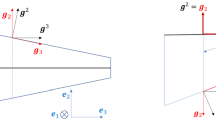Abstract
Plots of the stress function (obtained graphically from enlarged photos of the string net), and of the shear-stress distribution over the normal section of beams in cantilever loading, for beams of rectangular, and of circular section, compare well with the exact mathematical solutions. Regions of increasing stress, leading to points of stress concentration are clearly shown.
String nets were built for rectangular sections of ratio of half widthb to half deptha, R=b/a=1/4, 1/2, 1, 2, 4, 8. The form of the net forR≦|1| suggested the assumption of a plane for part of φ(x, y). ForR≫|1| another simple approximation was assumed for φ(x, y). The simple approximate mathematical analyses obtained from the values of φ(x, y) helped to show where the concentrations of stress are and how they vary withR.
Similar content being viewed by others
Bibliography
Mindlin, R. D., andSalvadori M. G., “Analogies,”Chapter 16 in Handbook of Experimental Stress Analysis, J. Wiley & Son, New York, N. Y. (1957).
Saint-Venant, “Mémoire Sur la Flexion des Prismes,” Jnl. Mathématiques (Liouville), (ser. 2), t. 1 (1856).
Griffiths, A. A., and Taylor, G. I., “The Problem of Flexure and Its Solution by Soap Film Methods,” Reports and Memoranda, No. 399 (Nov. 1917).
Timoshenko, S., andGoodier, J. N., Theory of Elasticity, 2nd ed., McGraw-Hill Co., New York, N. Y. (1951).
Timoshenko, S., “Membrane Analogy to Flexure,”Proceedings London Math. Soc., Ser. 2, 20, 398–407 (1922).
Sokolnikoff, I. S., Mathematical Theory of Elasticity, 2nd ed., McGraw-Hill Co., New York, N. Y. (1956).
Love, A. E. H., The Mathematical Theory of Elasticity, 4th ed., Dover New York, N. Y. (1944).
Southwell, R. V., An Introduction to the Theory of Elasticity, 2nd ed., Oxford Univ. Press, London (1941).
Reissner, E., and Thomas, G. B., “Note on the Shear Stress in a Bent Cantilever Beam of Rectangular Cross Section,” Jnl. Math. & Physics,XXV,No. 3 (1946).
“Table of Circ. and Hyperb. Sines and Cosines,” Natl. Bur. of Stds. Appl. Math., ser. 36, Supt. of Doc., U. S. Gov. Print. Office, Washington, D. C.
“Table of Circ. and Hyperb. Tangents and Cotangents, for Radian Arg., Columbia Univ. Press, New York, N. Y. (1953).
Southwell, R. V., “Relaxation Methods in Eng. Science,”Oxford Univ. Press, London (1940).
Southwell, R. V., Relaxation Methods in Theoretical Physics, Vol. 1 1946, Vol. II, Oxford Univ. Press, London (1956).
Salvadori, M. G., Numerical Methods in Eng., Prentice-Hall, New York, N. Y. (1952).
Author information
Authors and Affiliations
Rights and permissions
About this article
Cite this article
Tea, P.L. The string-net analog of flexure of prismatic beams. Experimental Mechanics 1, 167–175 (1961). https://doi.org/10.1007/BF02323085
Issue Date:
DOI: https://doi.org/10.1007/BF02323085



